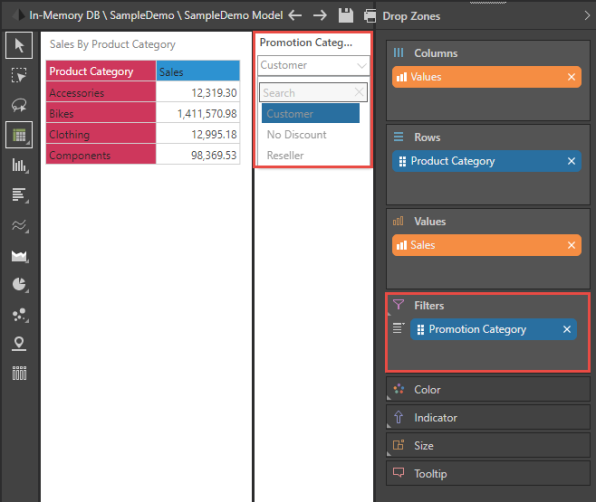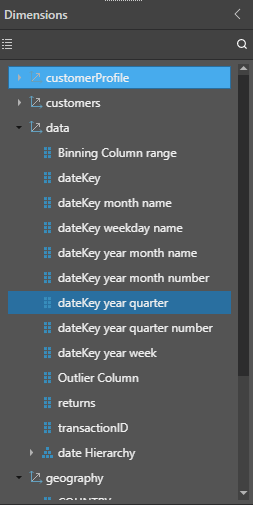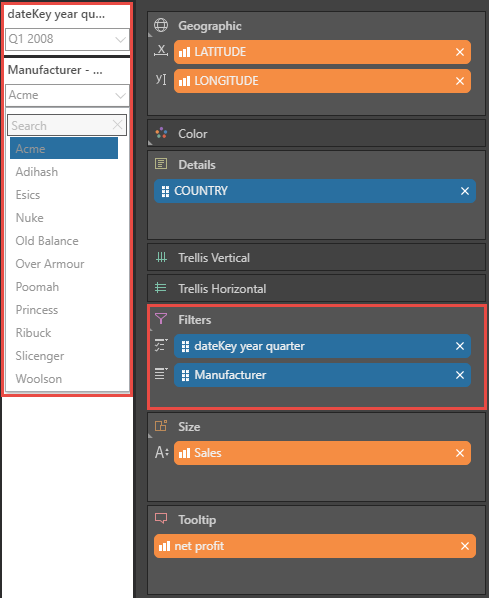The Filters drop zone is used to add 'slicers' or data-driven filters to the query. This lets users simply and conveniently filter their queries without needing to go and make selections in the Element trees.
When you "drop" a Dimension or Measure into the Filters drop zone you add a 'slicer' in the form of a drop-down list, buttons, or some other control (slicer type) to the visualization. Once the slicer is added, you can use it to filter your visualization by the given Dimension or Measure.
A "slicer" comprises a list of member elements from a model hierarchy that you can use to filter the query by one or more elements at runtime. For example, if you add the Country hierarchy to a drop-down slicer, you can use it to filter the data query to include data from just one selected country from the hierarchy.
Slicers can also be used with measures to drive slightly different mechanisms, including:
- A "switching" effect, where the measure can be swapped out using the measure slice. These are known as variable measure sets.
- A "parameterization" effect, where a VALUE filter can be built using a given measure to numerically filter the query. (see below for more information.)
Note: You can also create new Slicers for your visualizations in Tabulate (more information), and add the Slicers you created in Discover to Present so that they can be used at presentation runtime by your end users (more information).
Value or Numeric Filters vs Slicer Filters
Unlike classic slicers which are built off member elements found in hierarchies, value or numeric filters are built using numeric or text values. As described in more detail here, value filters generally limit data by specifying limits on values while slicer filters generally limit data by limiting element selections. Value filters can be added via the context menu (see Quick Filters), through a more advanced and comprehensive Filter Wizard; through building more sophisticated element lists; and finally via the Filter drop zone, described in this topic.
- Click here to learn more about value filters with parameters.
- Click here to learn more about these functions in the PQL documentation.
Slicers vs Parameters
Filter Slicers and parameters are highly related objects. All slicers are really parameters, which are built directly using the Filters drop-zone. However, parameters can be built and deployed using multiple other avenues and offer far greater analytic and visualization power (for example, the numeric filters described below).
Slicer Types
- Drop Down: Adds a drop-down list from which you can select one slice at a time.
- Multi Select Drop Down: Adds a drop-down list from which you can select multiple slices simultaneously.
- List Box: Adds a single-select list within a box container.
- Multi Select List Box: Adds a multi-select list within a box container.
- Text Box: Adds a textbox with drop-down.
- Buttons: Adds single-select buttons, rather than a list.
- Multi Select Buttons: Adds multi-select buttons.
- Multi Select Tree: Supports 'regular' hierarchies in both cube and SQL models. Adds a multi-select tree list; you can navigate through the tree to find and select relevant elements.
- Single Select Tree: Supports 'regular' hierarchies in both cube and SQL models. Adds a single-select tree list; you can navigate through the tree to find the relevant element.
- Date-Time Picker: The date-time picker is a specialized slicer visualization designed to make it easier to use date-time hierarchies and their associated calculations.
An additional option, Combined Elements filters the query by all the elements in the hierarchy that were added to Filters (rather than filtering by a specified slice).
Background Chips
When a single element is added to the query, it is added as a background chip.
- The chip is hidden from the filters drop zone by default. You can use the filter drop zones menu to show the chip instead.
- If more than one item is selected, the background chip is automatically switched to a slicer visual as per above instead.
- Background selections are shown on the canvas in Discover. You can hover over these items and then drag them to drop zones like a regular chip if needed. In Present, background selections are only shown in the breadcrumbs of the visualization.
Pre-Query Slicers
Another option, for all filters or slicers is to enable them for "pre-querying". This will force users to make selections from the filters BEFORE any queries are executed. This may both simplify the user experience and accelerate queries, since the initial choice is made before any default selections are run first. Click here for more on pre-query slicing.
Adding Filters
Adding Classic Element Slicers
To add a slicer, simply drag the relevant member hierarchy to the Drop Zone called Filters. By default, a drop-down slicer will be added to the page. You can also create a measure slicer on the fly, by adding multiple measures to the Values drop zone, and moving the Values chip to the Filters drop zone.

You can select a different slicer type by dropping the chip onto one of the options in the Filters zone menu.

Position the Slicer
- The slicer can be dropped into four docking zones on the canvas: right hand side (default), left hand side, top, and bottom
- To move your slicer to another docking zone, hover over the slicer title - the cursor will show as a move pointer (four arrows)
- Click and drag the cursor to one of the four docking zones
- When the docking zone displays a blue highlight, drop the slicer


Edit a Slicer
Click the slicer's context menu and select Settings to open the Slicer Settings dialog.
Adding Value Filters using the Filters Drop Zone
- Drag a value chip (orange) to the Filters drop zone.
Note: The choices offered on the sub-menu are different to those offered for blue hierarchical element filters. - Select the type of value filter to apply to your data set.
Note: All value filters built using the drop zone technique are automatically parameterized, allowing the user to further tweak the filter settings.

Using Slicers
Making Slicer Selections
Although making a basic selection fro a slicer is fairly intuitive, there are several advanced capabilities that can help users make more complex selections, this covers multi-select and slicer search. Click here for more.
Bookmarking
Once you have made certain selections across your filters or slicers, you can "bookmark" the selections. This lets you return to those selections quickly and easily in the future. For more information, see Bookmarks.
Example
STEP 1
The Year Quarter member was added to the Filters zone from the Dimensions panel.

STEP 2
From the Filters sub-menu, the date chip is dropped onto Multi Select drop-down to enable selection of multiple quarters from a drop-down list.

STEP 3
Now the Manufacturer member is also added to the Filter drop zone, to add a second slicer.
The visual can now be filtered by both quarter and manufacturer.
